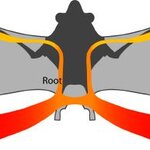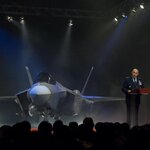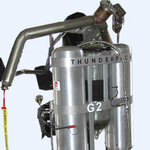Aerospace

Although it's been a half century since America entered the space age, the basic propulsion concepts used to push Explorer I into space will be the same type of propulsion that the nation will use to begin the next half century of space exploration.
It was January 31, 1958 when a Redstone-Jupiter C rocket developed in Huntsville, Ala., lifted the 30-pound artificial satellite into space.
Clark Hawk, director of the Propulsion Research Center at The University of Alabama in Huntsville (UAHuntsville) has seen most of the advances that have taken place in rocket propulsion. He has spent 50 years…

Sometimes scientists won't understand it even after they see it, but at least they'll believe it despite its improbability. Such is the case with bats, the bumblebee and the hummingbird, which according to classic wing theory should not be able to fly. Yet they seem to have forgotten to read that textbook.
In 1995, bumblebee flight got its answer. This week, the aerodynamics of a hovering bat species has been revealed. Its flight was studied in the wind tunnel laboratory of Lund University.
The wind tunnel at Lund University is specially crafted for research on bird flight. Birds fly “at…

NASA's Aeronautics Research Mission Directorate has amended its NASA Research Announcement to solicit additional research proposals. The Research Opportunities in Aeronautics 2007 has been amended to include new topics in support of the Subsonic Rotary Wing Project.
With the amendment, the Subsonic Rotary Wing Project encourages proposals that advance the state-of-the-art in engine compressor technology, transmission noise modeling, low-frequency noise effects and rotorcraft icing methodology.
The challenge of the project is to develop validated physics-based multidisciplinary design and…

Lt. Col. James "Flipper" Kromberg of the U.S. Air Force became the first military service pilot to evaluate the F-35 Lightning II, taking the aircraft through a series of maneuvers Wednesday on its 26th flight.
Kromberg took off from Lockheed Martin's Fort Worth plant at 11:54 a.m. CST, flew the plane to 6,000 feet and checked handling qualities at 15-degrees angle of attack. He then climbed to 10,000 and 12,000 feet assessing the up-and-away flight-control response. Kromberg also tested the F-35's engine performance and formation-flying characteristics.
"The aircraft flew very well,…

Scientific and Technical Aerospace Reports (STAR) is an online publication listing citations and abstracts of NASA and worldwide aerospace-related research. Updated biweekly, STAR highlights the most recent additions to the NASA scientific and technical information knowledge base.
for more information visit : http://www.sti.nasa.gov/Pubs/star

We've been waiting for a good personal jet pack system since seeing Sean Connery strap on that Bell-Textron thing in the opening sequence of Thunderball.
Thunderbolt Aerosystems founder Carmelo "Nino" Amarena must have seen that movie too because when he decided to try and shorten the grueling commute to his Bay Area office, he came up with what he says is a practical and economical personal air vehicle - one that won't blow up on your back like those hydrogen peroxide-powered prototypes of the early 1960s.
Don't get too excited just yet if you're a big guy. While the new version can stay…

http://www.sciencedaily.com/releases/2008/01/080109173722.htm
The above address is a post on Science Daily about an antimatter cloud. This should be of interest to the hard core science types and SiFi fans like myself.
The post describes an antimatter cloud that surrounds the galactic center. This cloud is about 10,000 light-years across. The European Space Agency’s "Integral" satellite has provided clues to the possible origin of this antimatter cloud. This post is well worth reading.
The author of this post quotes professor Marvin Leventhal, "I think I can hear a collective sigh of relief…

Cameras and sensors that will look for the presence of water on the moon have completed validation tests and been shipped to the manufacturer of NASA's Lunar Crater Observation and Sensing Satellite.
The science instruments for the satellite, which is known as LCROSS, departed NASA's Ames Research Center in Moffett Field Calif., for the Northrop Grumman Corporation's facility in Redondo Beach, Calif. to be integrated with the spacecraft. A video file is available on NASA Television. LCROSS is scheduled to launch with the Lunar Reconnaissance Orbiter aboard an Atlas V rocket from Cape…

The Japan Maritime Self-Defense Force successfully flight
tested its first Raytheon-built Standard Missile-3. The
SM-3 Block IA missile engaged and destroyed a medium-range ballistic missile target more than 60 miles above the Pacific Ocean.
Personnel at the U.S. Navy's Pacific Missile Range Facility on Kauai launched the ballistic missile target while the crew of the Japanese destroyer JS KONGO (DDG-173) fired the intercepting missile.
"Today's intercept truly paves the way for Japan to deploy a sea-based ballistic missile defense system," said Ed Miyashiro, Raytheon Missile Systems vice…

XCOR Aerospace, Inc. announced today that it has successfully completed its first series of tests on a new 56-pound thrust rocket engine. The engine, designated XR-3E17, is a direct
descendent of the company's XR-2P1 "Tea Cart" engine developed in 2000.
Although it weighs just half as much as its predecessor, the new engine has nearly four times the thrust of the 15lb thrust original. The regeneratively cooled engine, developed using private investor funding, is made of copper with a lightweight aluminum cooling jacket.
The XCOR XR-3E17 56lb-thrust rocket engine is shown here with a 6-inch…